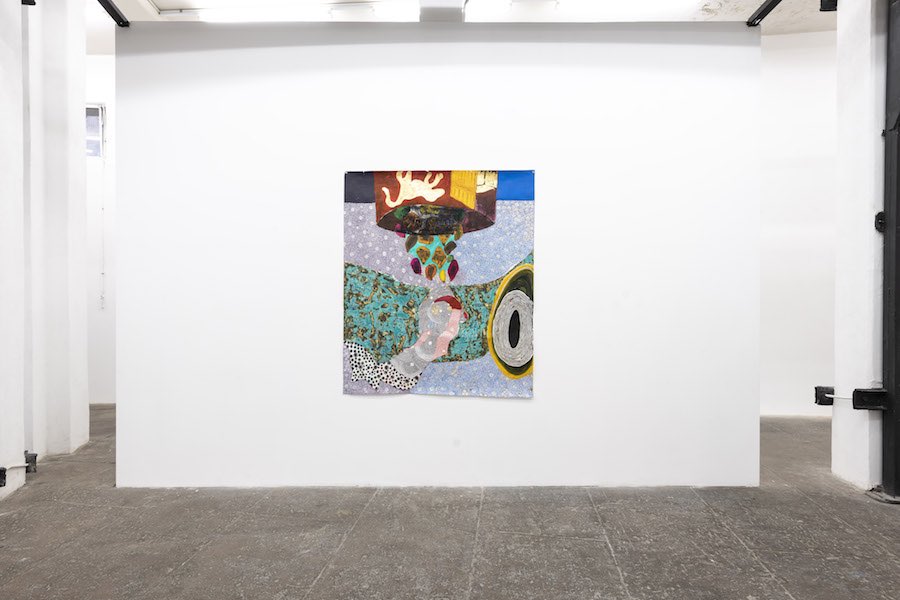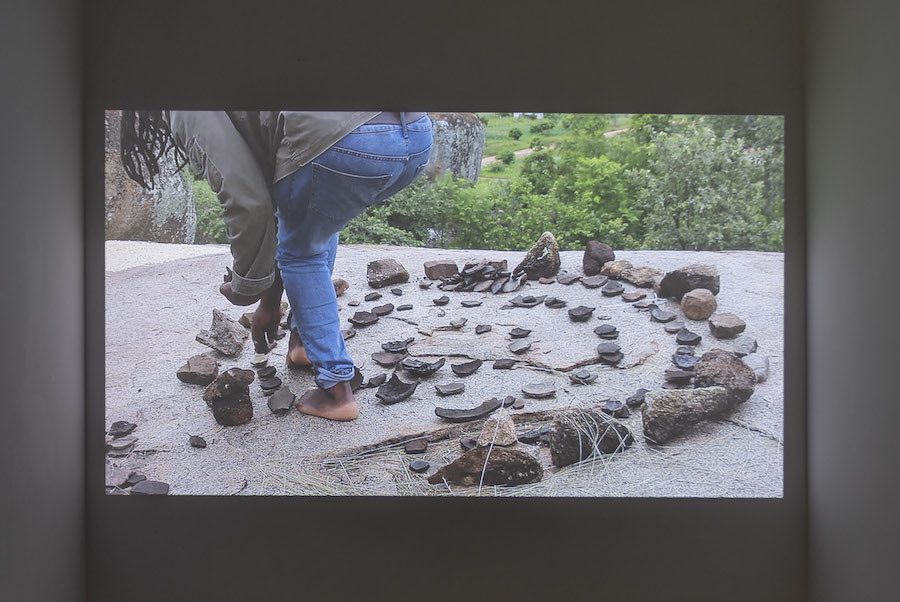
Interview by Costanza Savelloni —
Kuedza Mudzimu nesengereis the title of Tendai Mupita’s (1990, Harare) first solo exhibition in Italy and Europe, during which his most recent series of large drawings and video installation are presented to the public. The title of the show – hosted by T293 gallery in Rome – recalls an ancient saying in Shona, the artist’s native language, which could be translated as “those who are willing to take dangerous risks”, “those who are inclined to make vain efforts”, metaphor of the almost mystical practice that the artist lives during the artistic process. The large scale drawings are studded with an infinite number of small circles. Obsessively repeated throughout they create a macrocosm within which it is possible to trace elements taken from the cultural, religious and spiritual tradition of Africa. A truly contemplative journey in which the spectators are encouraged to not only retrace the elements dispersed by the artist, but also by themselves.
On show until 31 July 2020.
Costanza Savelloni; This exhibition in the T293 spaces marks your debut in Italy and Europe. How do you feel about it and how did the collaboration with the gallery begin?
Tendai Mupita:It is an overwhelming feeling and scary at the same time because I do not know how the new audience will look at work. I was waiting for the opportunity to present my work on international platforms and this is a great feeling for people to see my perception of life. The collaboration with gallery began last year when I just returned from the US after my completion of Skowhegan residency. They got in touch with me and we discussed about my process and future shows. I’m looking forward to see how my practice improves working with the gallery.
CS: A series of large drawings, studded with small circles which create a repetitive rhythm, almost tribal, to the shamanic movement of your brushstroke, through which you guide us in microscopic microcosms, abandoning us to ourselves, contemplating, lost in your work. It seems almost as though, paraphrasing the title of the show, you’re ready to incur in those “dangerous risks”, performing those “wasted efforts” in regards to our society, not very inclined to meditation.
TM: The idea of risk is something that readily presents itself in any instance of leading a contemporary existence that is in constant commute with tradition and culture. As is the case with traditions in other cultures, Shona culture exists with traditional practices, folklore and beliefs as a fundamental part of community life. I suppose that with anything that in as much as tradition is important to me and informs who I am, I cannot necessarily neglect the time I live in to favour history and the way things have historically been done so as to maintain cultural traditions. What happens rather is that the practices of my people, my ancestors evolve and adapt to the environment that I find myself in as a Shona man in the 21st century. For example, family histories and relations are strongly linked to wildlife. Everyone has family totems and my wife and I just so happen to have the same totem, the baboon. I found out that my great grandfather, an artist and bearer of the baboon totem, had also married someone of the same totem. To me, that is in a way “taking a risk” as it is taboo to marry someone of the same totem. It is also in one way a realisation of a cycle and circle when I think about my family’s history and consider my great grandfather. We have both taken similar risks without known what might come from it. Having said this, I do not think that anything declines necessarily because of Western society but really that it can be realized differently and/or evolve and so no effort is as wasted as one might initially presume.


CS: The imagery which you draw upon is the African space, the landscape, villages, animals and textiles that populate it. Through this sort of molecular drawing, you dismantle to a minimum the cosmos that envelops you, once again inviting the spectator to form an intimate connection to your works. I would like for you to illustrate the idea of the circle as a sacred space belonging to your culture and how you believe this could be declined in Western society.
TM: The circle as a form is of no relevance without the “material” that it is made of. The practices, events and material that come together to make the circle are what make it a sacred space. These things are wholly sacred themselves by way of coming together to form a sort of community. Shona houses are normally built as circular forms in a more or less circular formation in on the family’s compound. In the kitchen, one will often find a circular cooking portal. This portal is traditionally built by putting stones from a river together. These same stones are also generally used for burnishing cooking pots. The cycle through which seemingly everyday things go present something of a circle by which we can observe the interconnectedness of all things. Another aspect to note about the (circular) kitchen space is that it is often a space wherein family discussions, decision-making and a clearing of the air of some sort occurs and that sacredness associated with the circle is further reveal in that space of communication.
CS: However, the elements of this universe are not all similar. The attentive spectator’s eye will not fail to observe the natural, animal and hybrid components that lurk in the myriad of micro-circles, erasing any hierarchy between living beings. What is the meaning you want to convey?
TM: The hybridity in the work comes largely from a consideration of a combination of folklore, cyclical traditional practices like the instance with the burnishing stones and the presence of animal totems thrpoughout Shona culture. In a way, the hybridity is in itself likely the most important expression of the circle and cycle of life which I continually reference. As you can imagine, if every family and person within Shona culture is associated with a particular animal totem, with every marriage between two Shona people and with the birth of a child between people of different totems comes both an inheritance of one’s father’s totem and a union of toems. This mixing of totems is a combining of histories and also family-specific traditions in some cases. In these relationships, the belief is that there is an interdependency between animals, between people and between people and animals. In much of the same manner that my work may present the preservation of cultural tradition, the relationships between animals and Shona people represent the preservation of life. To me, the hybrid figures are how I imagine the coming together of totems and people (the ancestors). They are also an instance of looking back to understand my contemporary existence alongside ancestoral generations.











